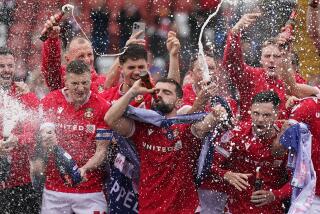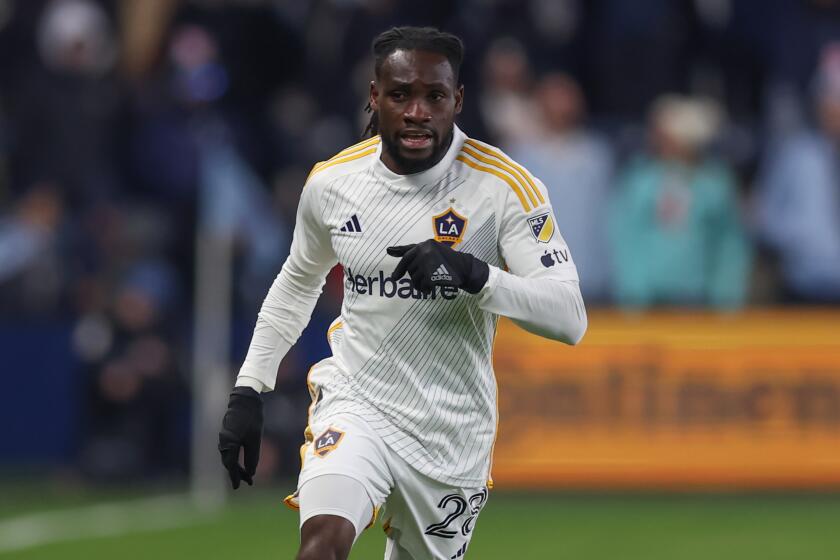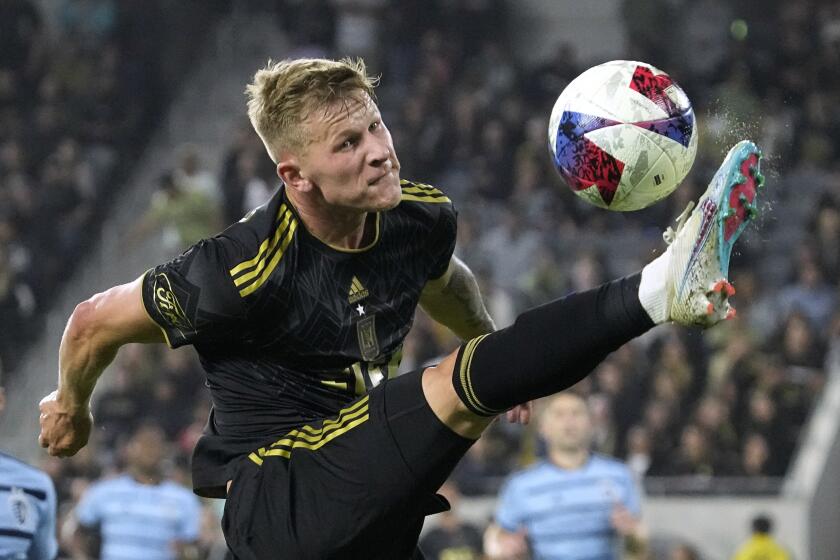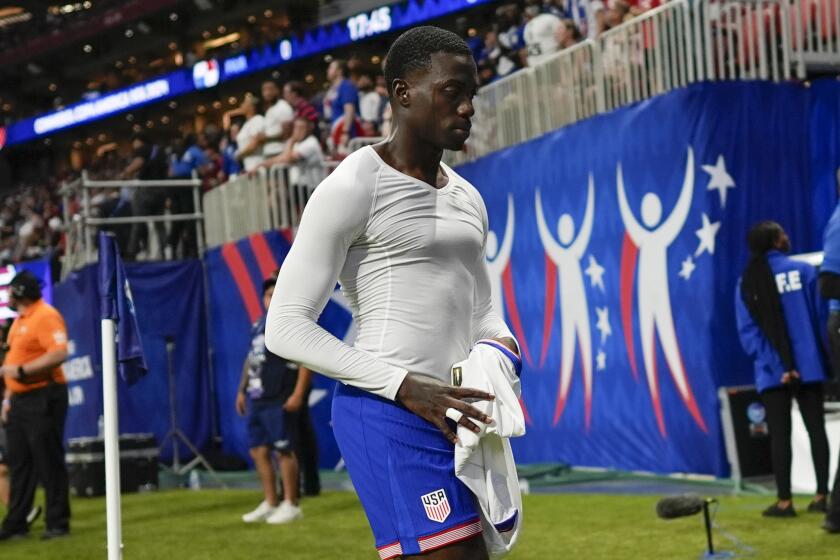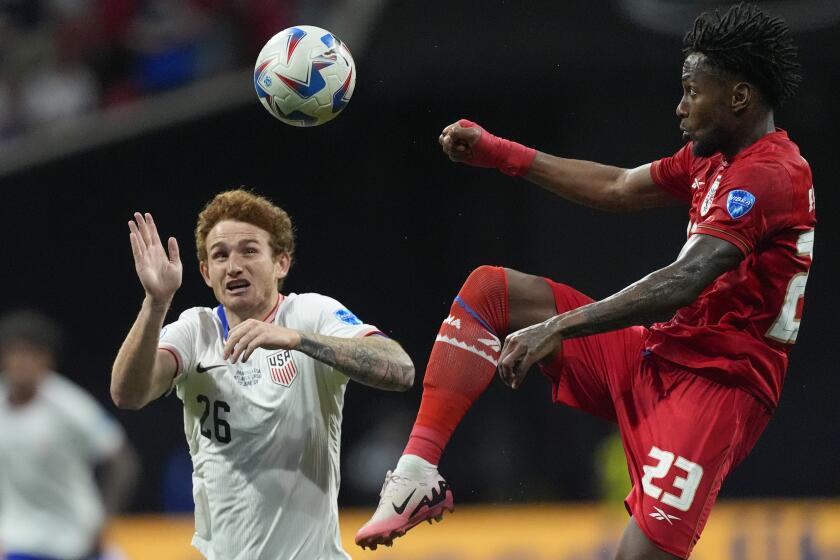SOCCER / JULIE CART : Controversy, Second-Guessing and Analysis? It’s About Time
The best thing that has happened to the U.S. national team this year has been what has come to be known as “the goalkeeper controversy.” This played out last week when the U.S. Soccer Federation selected Jurgen Sommer as its third World Cup goalkeeper, thus eliminating the highly regarded Kasey Keller from the team.
The second-guessing and analysis began immediately: arguments about the relative strengths of each of the three, the possible political motivations for the selections, the practical impact for the U.S. team against World Cup opponents. This and other decisions of U.S. Coach Bora Milutinovic were again scrutinized and criticized.
Soccer officials are skittish, as always, at any hint of disagreement in the happy family. Their attitude is wrongheaded. This entire episode is the first sign anyone has seen that soccer is being taken seriously here.
Controversy is exactly what happens in “mainstream” sports when decisions are made. Fans praise or complain. Insiders look for hidden agendas. Debate is stirred. It’s what sports in the United States are about. You want people talking.
The best thing that could happen to soccer would be if radio sports-talk show hosts stopped making fun of it and began analyzing such decisions. Fans talk about things they care about.
Here’s another way to view it: Which is better, selecting a World Cup team with an inevitable shrug because the talent pool is so shallow, or generating intense competition among qualified candidates? A surplus of skilled goalkeepers isn’t the problem. It’s a lack of competition that should worry soccer officials.
There will be more criticism when roster cuts are made. At least someone cares. At least some fans are informed enough to have an opinion. A little noise is surely better than deafening silence.
*
As for Keller, give him high marks for class. It would be natural for him to feel snubbed, because he got precious few scouting visits as he went through his second outstanding season for Millwall in the English First Division.
But when he did finally discuss the decision last Friday from his apartment in London, Keller was professional and resigned.
“It was definitely something I had in the back of my mind,” Keller said of the possibility that he would not be selected for the World Cup team. “It was something I was well prepared for, even to the point of discussing doing some British (television) commentary during the World Cup.
“I just thought that what I had done (at Millwall) for the past year had to filter through somehow. It didn’t, I guess. I’m disappointed, but I did all I could do and I have a good, stable professional career here that I have built.”
Keller was eager to dispel a rumor that he was not selected because his ego would not allow him to sit quietly while someone else started. “I don’t want anybody to think it was an ego thing on my part,” he said. “That I was too big to be part of the team and not play. I would have been happy to have come in and give the benefit of my experience, even if I didn’t play.”
Keller was Tony Meola’s backup in the 1990 World Cup and, at 24, he has other chances, provided the United States can qualify. If not, Keller has established an excellent reputation in England and now has a transfer fee value of 1 1/2 million pounds, about $2.5 million.
“This is a personal setback, but it won’t hurt my career,” Keller said. “My game is improving every day. That’s what’s important.”
*
The latest foreign-based players to report to camp are striker Ernie Stewart and defender Cle Kooiman. Stewart was released by Willem II in the Dutch First Division to train with the U.S. team. Kooiman finished the season with Cruz Azul in the Mexican First Division.
Both players attended last Saturday night’s game against Estonia and are expected to begin practicing with the team Wednesday.
Stewart has played only 14 games with the national team, but that belies his crucial role for the team, as the probable starting striker in Milutinovic’s single-striker system. Stewart and Cobi Jones are the fastest players on the U.S. team.
Kooiman is a rugged defender who has served as captain of Cruz Azul, an honor seldom accorded a non-Mexican player. Unlike the offensive players who will return from Europe, Kooiman joins an almost intact defense that has been playing together for more than a year.
*
What is happening with the proposed professional soccer league? Not much.
That sums up the investment interest in Major League Soccer, which has announced it will begin operations next spring. The league has been seeking $100 million in initial investment, $60 million of it in cash--astonishing figures in the current economy.
Indications are of massive retrenchment by MLS. Investors were at first required to put up $10 million each, but now that figure has been halved. Additionally, sources say, the league has gone to Wall Street to seek financing.
The 12 franchise cities are to be announced June 15 and it looks doubtful that each will have met one major criterion for selection: The sale of 10,000 season tickets.
Another potential financial blow was dealt a few weeks ago, when the USSF executive committee shot down an MLS proposal that the pro league assume marketing rights for the U.S. national team and the Olympic team. Someone noticed those rights were already held by Soccer USA Partners (SUSAP), which the USSF contracted to promote the teams.
Then there is the matter of players. If the 12 teams have rosters of 18, the new league will need 216 players. Allowing for four foreign players on each team, that leaves room for 168 American professional players. Where are they?
Take every player off the World Cup roster, assuming the new league could pay the millions in transfer fees for the foreign-based players, and assuming the players would want to play in the MLS for less money, and 146 players still would be needed.
Most of the best of the rest of the American players are under contract to American Professional Soccer League (APSL) teams, and those teams could not be expected to happily turn over their players to their rival, the MLS.
So where is the MLS going to get its players? In addition to the APSL’s players, the MLS covets the stadiums the APSL has under lease. The San Francisco Blackhawks have already announced their bid for an MLS franchise--look for other APSL teams to follow suit, as the MLS comes courting.
William De La Pena, owner of the Los Angeles Salsa, confirmed that he has talked with MLS representatives about joining the new league. The problem: De La Pena wants to own his own team and not be part of the MLS single-entity concept.
De La Pena says there’s room for compromise, but it appears the APSL has all the leverage.
